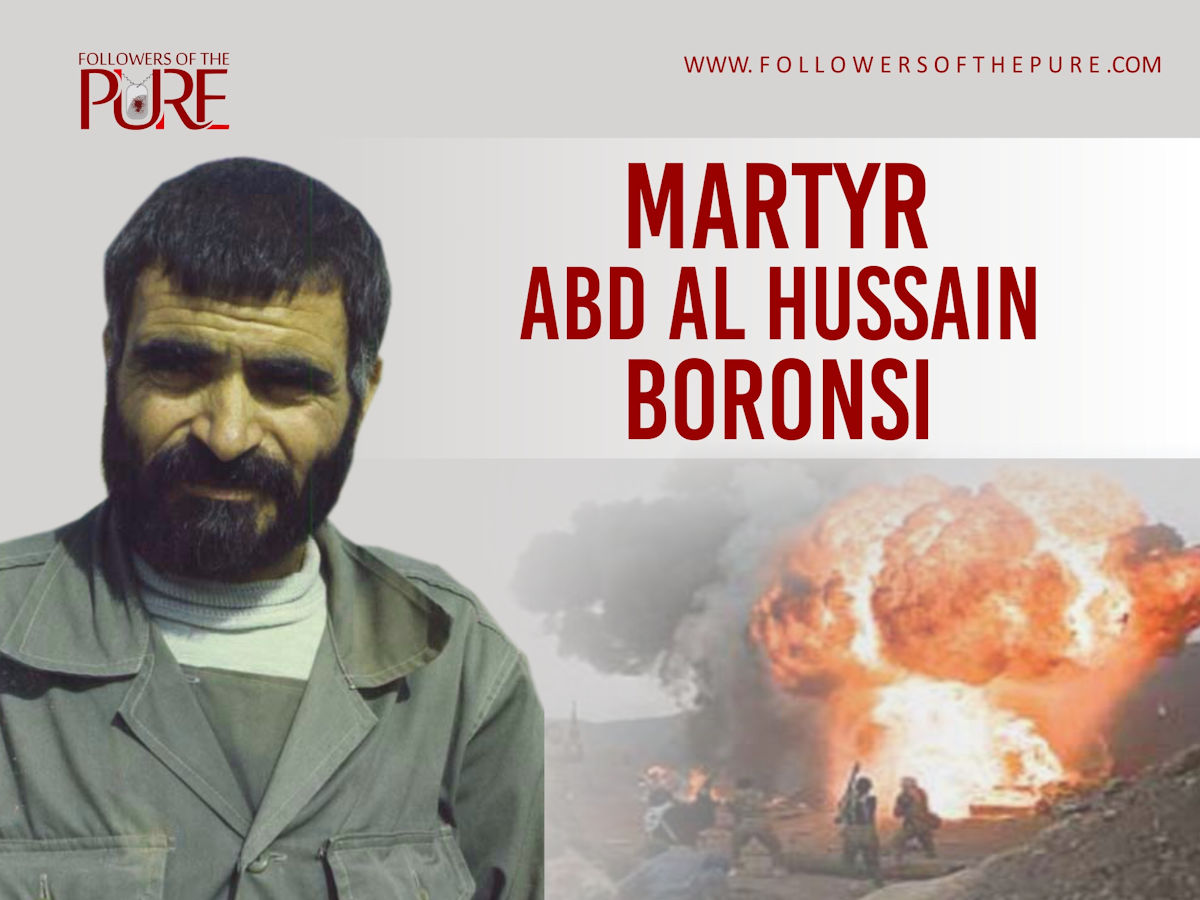“The enlightened soul” is a person who is self-conscious of the condition in his time and historical and social settings, and whose awareness inevitably and necessarily gives him a sense of social responsibility. The “Enlightened soul” is an aware and responsible individual who’s most important objective and responsibility is to bestow the great God given gift of “self awareness” to the general public. Only self awareness transforms static and corrupt masses into dynamic and creative cantor, which fosters great genius and gives rise to great leaps which in turn became the springboard for the emergence of civilization, culture and great heroes.
Martyr Abd-Al-Hussain Boronsi, in the midst of darkness of the devilish society performed his Islamic obligation. He is an example of such an “Enlightened soul” who identified the “truth” and invited us to initiate a journey which would undoubtedly lead us to our final destination.
Abd-Al-Hussain Boronsi was born in 1942 in the Village of Torbat-e-Heydarieh County, Razavi Khorasan province, Iran. In his early life he worked in Construction Company whilst studying religious texts on the side. He spent five years to study Islamic Sciences. Martyr Boronsi was one of the fighters against Pahlavi dynasty that was repeatedly arrested and tortured by Savak, before the Islamic revolution of Iran. The stories of Savak’s atrocities had acquired world wide publicity. The Secretary General of the Amnesty International had announced in 1975 that the performance record of no country in the world in regard to human rights is as dark as Iran. The Savak used to arrest anyone it wanted. There were no laws or regulations to limit its activities. The Savak did not know any restrictions to hold on people arrested by it nor did it grant any rights or facilities to the people arrested. Its power was absolute, and fully despotic. He was a victim of Savak savageries, Martyr Boronsi sharing his personal experience says, “the prisoners were kept in small damp cells which had only one straw mattress, and they used to take turns to sleep. Savak had effective and crafty ways of weakening the moral of the prisoners, a prison guard pointed a gun on my chest and the other one pressed the gun on my back and slapped me hard, demanded to know who my friends were. To this I replied, “I am alone.” They threatened to kill me countless times. On one instance they punched me so hard on my face that my teeth broke, but I never surrendered. The lack of heating during the winter and cooling during the summer season had made the conditions much harder. Washing and cleaning facilities were inadequate, ration was little and inappropriate and no medical facilities were provided at all. The executioners and the tormentors have remained in history as the most ruthless people of humanity. Prisoners were tortured and put to death in a most heinous manner against all standards. Martyr Boronsi endured this…
After the triumph of the Islamic Revolution of Iran, he joined the Army of the Guardians of the Islamic Revolution at the beginning of the Iran-Iraq war. During this time he had various responsibilities in war. The “Balal Battalion” by his commanding during the “Operation Val- Fajr 3” captured the heights of “Kale- Ghandi” and was responsible for the capture of “Colonel Jassim Jacob” the groom and cousin of Saddam Hussain.
He was martyred on 14th March 1985, in the operational area of, “Operation Badr” whilst he was commanding the 18th Brigade of Javadol Aemeh. His body was left in the operational area. According to ‘Sayyid Muhammad Baqirzadeh’, President of the Foundation for preservation of the monuments and valuables of the holy defense, body of Martyr Boronsi was discovered after 27 years of his martyrdom in the east of Tigris along with other twelve soldiers. He was buried on the anniversary of Fatimah bint Muhammad in Mashad. Men like Martyr Boronsi, with all the restrictions and limited possibilities at their disposal tried their best to convey the message of true Islam to the young generation of the country. He considered it his duty to help the true combatants of Islam.
The book “Khak-haye narm-Kooshk” {soft soils pavilion} titled in English under the name “Boronsi” is a collection of Boronsi’s memories narrated by his wife ‘Masoume Sabokkhiz’ and his fellow soldiers, written by ‘Saeed A’kef’. The book was first published in Persian by “Mulk Azam Publications” in 2004 and has been reprinted over 200 times since. It is amongst the best selling books in Iran. This book is regarded as a sacred defense book in Iran, as it explores the life of Boronsi through the memories of his wife and friends. The book presents 70 short narratives about the character and personality of the life of the commander, each one coupled with a photo of Boronsi. The book has been translated into many languages including Urdu, Arabic, Turkish and English. “Boronsi” was presented at the “Frankfurt Book Fair” in 2011. The film “Be Kaboodi- ye yas” is an adaptation of Boronsi’s life.
‘Abd-Al Hussain Boronsi’ the name itself is built from the Arabic words Abd and Hussain which means ‘Servant of Hussain’. And ‘Servant of Hussain’ he truly was…
Ayatollah Khamenie says regarding Martyr Boronsi,
“In recent years, many books have been published about the martyrs of Iran-Iraq war. I am a strict follower of these books. I know some of the heroes of these books. I understand that they are exalted or loyal to the world. Some of them joined the front with their work clothes… Martyr Boronsi, a masonry master was one of them. I knew this great personality closely, so I recommend you to read this book about his life.”

